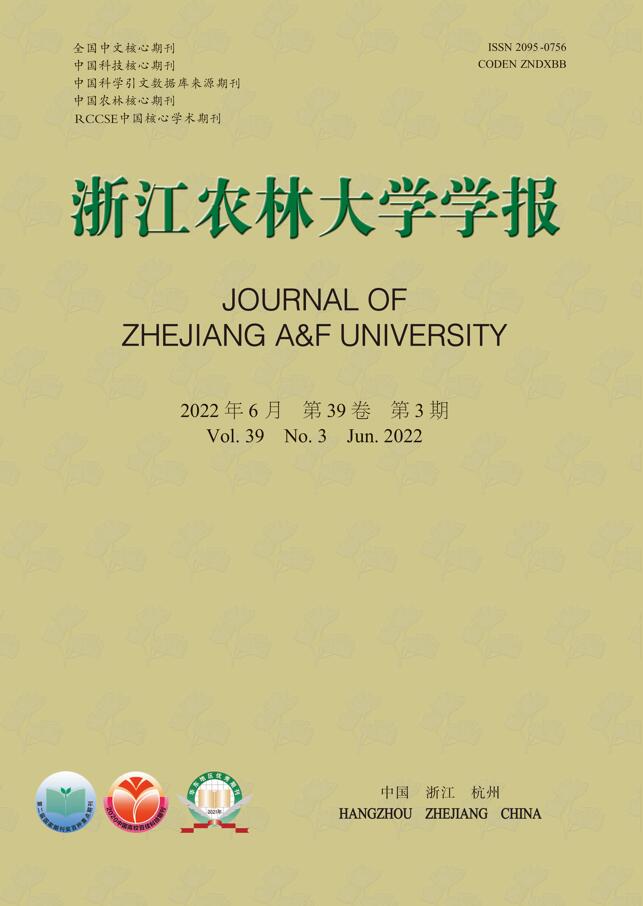-
黄腹角雉Tragopan caboti隶属鸡形目Galliformes雉科Phasinidae角雉属Tragopan,分布于湖南东南部、浙江南部和西南部、江西、福建、广东北部和广西东北部,是中国特产濒危雉类,国家一级重点保护动物,全国估计有4 000只,被列入《中国濒危动物红皮书·鸟类卷》[1]。
自20世纪80年代发现黄腹角雉以来,在浙江乌岩岭国家级自然保护区(1994年之前为省级)对黄腹角雉的研究,主要涉及栖息地和巢址选择、栖息地片段化、食性、人工受精繁殖、越冬与迁移、种群结构与动态、种群生存力分析等方面的内容[2],这些都为自然保护区黄腹角雉种群的科学保护提供了指导建议。本研究对浙江乌岩岭国家级自然保护区内黄腹角雉的最新分布范围进行了调查和分析,以期对前期保护效果进行评估,并为今后保护工作提供建议。
-
浙江乌岩岭国家级自然保护区(27°20′52″~27°48′39″N,119°37′08″~119°50′00″E)由原乌岩岭省级自然保护区在1994年扩大范围并经国务院批准而晋升为国家级。扩区、晋级后面积为1 881.6 km2,下辖双坑口、碑排、黄桥、垟溪等4个保护站,涉及乌岩岭林场的国有林,罗阳、司前、竹里、西旸等4个乡镇12个行政村的集体林。属于亚热带海洋性季风气候,以次生植被为主,但保存着大面积完整的原生性常绿阔叶林[3]。宋永昌等[4]认为:乌岩岭地区所保存的常绿阔叶林植被比较完整、典型,被认为是中国亚热带常绿阔叶林东部地区保存较好的地点之一。
保护区动植物资源非常丰富,近年来陆续发现了一批新种、全国新分布种、浙江新分布种[5-11]。珍稀物种较多,国家一级保护植物有5种,国家一级保护动物有8种[3]。国家一级保护动物中,鸟类有黄腹角雉与白颈长尾雉Syrmaticus ellioti。作为全国主要的黄腹角雉保种基地与科研基地,做好黄腹角雉种群的调查、监测是该保护区的重要工作之一。
-
自2019—2020年,采用样线调查法、红外相机调查法对浙江乌岩岭国家级自然保护区黄腹角雉分布进行了调查。样线布设时最大限度地利用现有护林路及防火线,可利用里程为60 km。对间距超出1 km的区域进行线路加密,加密里程为25 km。样线总长度达85 km,基本遍及保护区的各类典型区域。样线调查结合巡护工作每季度开展1次,调查中携带望远镜、照相机,进行必要的影像与文字记录。红外相机调查主要在双坑口、碑排2个保护站所辖区域开展,2019年在双坑口、2020年在碑排分别布设红外相机100台,布设时间均为1 a,2 a共布设200台次。红外相机的设置及照片判读参照章书声等[12-13]的方法。红外相机位点选择总体上采用随机原则,位点间保持直线距离为500~800 m,尽量呈均匀分布,并确保每平方公里范围至少布设1台红外相机。但在局部位置确定上,则要根据地形、植被情况,尽量选择黄腹角雉可能出现并被监拍到的方位。相机安装高度为0.2~1.5 m(结合地形及相机朝向确定),每季度更换电池与内存卡。由于保护区地形地貌复杂与人为干扰等因素,红外相机存在遗失与被偷盗情况,在双坑口、碑排保护站所辖区有效收回的相机分别为95、92台。
对发现黄腹角雉分布点的经纬度、海拔、植被类型、个体数量及性别等相关情况进行记录,并对不同分布区(保护站)、不同植被类型与不同海拔范围进行统计。
-
研究表明:黄腹角雉栖息地为海拔800~1 400 m的常绿阔叶林和常绿针阔混交林[14],全年最大扩散距离为3 km[2, 15]。通过实地调查,结合ArcGIS图像判读,分析各个分布点周边的森林植被类型、海拔高度及地形地貌等相关因素,逐个地块判定黄腹角雉分布的区域范围。如在某一地块发现黄腹角雉,则在同一座山体中自该分布点上至海拔1 400 m,下至海拔800 m范围,植被类型为阔叶林、针阔混交林(包含小面积的其他林种),距离3 km以内(实际中大都达不到3 km)的地域予以确认为黄腹角雉分布范围。分布点以外较大面积(1 hm2以上)的农用地、毛竹Phyllostachys edulis林、针叶纯林予以排除,被其他地类完全隔离的阔叶林、针阔混交林也不予以确认。将相邻分布地块合并后的分布范围按不同保护站转绘到ArcGIS 10.0软件系统中,自动求算各分布区面积。
-
总共调查到黄腹角雉分布点69个,其中通过样线调查发现的分布点为54个,通过红外相机拍照发现的分布点为15个。双坑口、碑牌、黄桥、垟溪4个保护站均发现有黄腹角雉分布,分布点分别为37、15、11和6个。各分布点的记录详见表1。
分布区 分布点 经纬度 海拔/m 植被类型 数量与性别 调查方式 双坑口 S1 27°40′60″N,119°41′15″E 860 阔叶林 1雄 样线调查 S2 27°40′55″N,119°41′10″E 1 110 阔叶林 1雌1雄 红外相机调查 S3 27°40′54″N,119°40′53″E 1 070 针阔混交林 1雄 样线调查 S4 27°20′42″N,119°40′45″E 1 040 针阔混交林 1雌 样线调查 S5 27°41′23″N,119°40′21″E 1 180 针阔混交林 1雌1雄 样线调查 S6 27°41′19″N,119°39′56″E 1 230 针阔混交林 3雄 样线调查 S7 27°41′29″N,119°39′50″E 1 380 针阔混交林 1雌3幼 红外相机调查 S8 27°41′38″N,119°39′56″E 1 310 针叶林(柳杉) 1雌3幼 样线调查 S9 27°41′46″N,119°40′02″E 1 190 阔叶林 1雌 样线调查 S10 27°41′59″N,119°40′18″E 1 220 针阔混交林 1雌3亚 样线调查 S11 27°42′08″N,119°40′21″E 1 120 针叶林(柳杉) 1雌2幼 红外相机调查 S12 27°42′13″N,119°40′21″E 1 030 针阔混交林 1雄 样线调查 S13 27°42′13″N,119°40′16″E 1 070 针阔混交林 1雌 样线调查 S14 27°41′57″N,119°40′31″E 1 045 针阔混交林 2雄 红外相机调查 S15 27°42′16″N,119°40′09″E 995 阔叶林 1雌 样线调查 S16 27°42′18″N,119°40′03″E 915 阔叶林 1雌1雄 样线调查 S17 27°42′48″N,119°40′13″E 843 针阔混交林 1雌 红外相机调查 S18 27°42′50″N,119°40′05″E 772 阔叶林 1雄 样线调查 双坑口 S19 27°42′30″N,119°39′50″E 680 阔叶林 2雌 红外相机调查 S20 27°41′09″N,119°41′13″E 741 阔叶林 1雌1雄4亚 样线调查 S21 27°43′02″N,119°39′47″E 957 阔叶林 1雌 样线调查 S22 27°42′57″N,119°40′01″E 882 阔叶林 2雌 红外相机调查 S23 27°40′16″N,119°40′16″E 860 针阔混交林 1雄 样线调查 S24 27°41′31″N,119°41′35″E 1 193 毛竹林 2雌2雄 样线调查 S25 27°41′43″N,119°39′27″E 1 221 针阔混交林 1雄 红外相机调查 S26 27°42′03″N, 119°39′06″E 1 300 针阔混交林 2雄 样线调查 S27 27°42′38″N,119°38′52″E 1 065 阔叶林 1雌 红外相机调查 S28 27°42′49″N,119°38′49″E 1 325 针阔混交林 1雄 样线调查 S29 27°42′45″N,119°38′43″E 1 405 针阔混交林 1雌 样线调查 S30 27°42′55″N,119°38′36″E 1 550 针阔混交林 1雌 红外相机调查 S31 27°42′58″N,119°38′40″E 1 495 针阔混交林 2雌1雄 样线调查 S32 27°43′10″N,119°38′50″E 1 135 针阔混交林 1雄 样线调查 S33 27°43′52″N,119°39′36″E 1 210 针阔混交林 1雌2雄 样线调查 S34 27°43′41″N,119°39′51″E 1 155 针叶林(杉木林) 1雌 红外相机调查 S35 27°44′36″N,119°41′10″E 750 阔叶林 1雄 样线调查 S36 27°45′26″N,119°42′48″E 980 阔叶林 1雄 样线调查 S37 27°45′56″N,119°43′32″E 1 100 针阔混交林 1雌2幼 样线调查 碑排 B1 27°40′31″N,119°39′23″E 710 阔叶林 1雌3幼 红外相机调查 B2 27°40′11″N,119°40′11″E 690 阔叶林 1雌 样线调查 B3 27°41′13″N,119°39′52″E 1 270 针阔混交林 1雌3亚 样线调查 B4 27°41′19″N,119°39′43″E 1 170 针阔混交林 1雌2幼 红外相机调查 B5 27°41′36″N,119°39′06″E 1 390 针阔混交林 1雄 样线调查 B6 27°41′12″N,119°38′38″E 1 340 针阔混交林 1雌 样线调查 B7 27°40′39″N,119°39′17″E 782 阔叶林 2雄 样线调查 B8 27°40′7″N,119°39′16″E 760 针阔混交林 1雌 样线调查 B9 27°41′14″N,119°39′22″E 1 070 针叶林(柳杉林) 1雌1雄 红外相机调查 B10 27°40′19″N,119°38′44″E 1 090 针阔混交林 1雌 样线调查 B11 27°39′03″N,119°38′29″E 1 120 阔叶林 1雄 样线调查 B12 27°38′05″N,119°38′32″E 1 170 针阔混交林 2雌 样线调查 B13 27°40′14″N,119°39′57″E 772 阔叶林 1雌2雄 样线调查 B14 27°40′28″N,119°40′31″E 1170 针阔混交林 1雄 红外相机调查 B15 27°40′19″N,119°40′17″E 910 阔叶林 2雄 样线调查 黄桥 H1 27°46′05″N,119°44′39″E 905 针阔混交林 1雌 样线调查 H2 27°46′07″N,119°44′56″E 920 针阔混交林 1雄 样线调查 H3 27°46′02″N,119°44′56″E 830 针阔混交林 2雄 样线调查 H4 27°46′10″N,119°45′35″E 995 针阔混交林 1雌 样线调查 H5 27°46′33″N,119°46′41″E 850 阔叶林 1雌1雄 样线调查 H6 27°46′48″N,119°46′24″E 860 毛竹林 1雌 样线调查 H7 27°46′54″N,119°45′42″E 905 针阔混交林 1雄 样线调查 H8 27°47′19″N,119°47′53″E 720 阔叶林 2雌 样线调查 H9 27°47′02″N,119°48′19″E 835 阔叶林 1雌2幼 样线调查 H10 27°48′11″N,119°49′27″E 910 针阔混交林 1雌2亚 样线调查 黄桥 H11 27°48′29″N,119°48′18″E 775 阔叶林 1雄 样线调查 垟溪 Y1 27°21′51″N,119°45′21″E 705 阔叶林 1雄 样线调查 Y2 27°21′46″N,119°45′18″E 850 针阔混交林 1雄 样线调查 Y3 27°21′54″N,119°45′43″E 903 针阔混交林 2雄 样线调查 Y4 27°22′22″N,119°46′01″E 1010 阔叶林 1雌 样线调查 Y5 27°22′20″N,119°46′18″E 915 针阔混交林 1雄 样线调查 Y6 27°22′15″N,119°45′34″E 720 阔叶林 1雌 样线调查 说明:“亚”即黄腹角雉亚成体,“幼”即黄腹角雉幼体;柳杉Cryptomera fortunei,杉木Cunninghamia lanceolata Table 1. Population quantity of T. caboti
按植被类型统计,黄腹角雉在常绿阔叶林分布26只,占37.7%,在针阔混交林分布37只,占53.6%,其他植被类型(针叶林及毛竹林)分布6只,占8.7%。针阔混交林的分布点最多,其次为常绿阔叶林,其他植被类型则较少。按海拔范围统计,黄腹角雉在海拔800~1 400 m分布53只,占76.8%;其他海拔分布16只,占23.6%,其中海拔800 m以下分布13只,占18.8%,海拔1 400 m以上分布3只,占4.4% (表2)。
分布区 分布数量/只 按植被类型的黄腹角雉分布 按海拔范围的黄腹角雉分布 阔叶林 针阔混交林 其他 800 m以下 800~1 400 m 1 400 m以上 数量/只 占比/% 数量/只 占比/% 数量/只 占比/% 数量/只 占比/% 数量/只 占比/% 数量/只 占比/% 双坑口 37 13 35.1 20 54.1 4 10.8 4 10.8 30 81.1 3 8.1 碑排 15 6 40.0 8 53.3 1 6.7 5 33.3 10 66.7 黄桥 11 4 36.4 6 54.5 1 9.1 2 18.2 9 81.8 垟溪 6 3 50.0 3 50.0 2 33.3 4 66.7 合计 69 26 37.7 37 53.6 6 8.7 13 18.8 53 76.8 3 4.4 Table 2. Statistical table of distribution of T. caboti
调查中发现:在靠近防火线与山脊线的边缘区域、以及与其他植被类型交界的过渡区域,黄腹角雉分布数量相对较多,而核心区域黄腹角雉反而较少,可以初步确定黄腹角雉种群分布存在边缘效应。此外,在低海拔地带及保护区最南面的洋溪分布区,并未发现黄腹角雉依赖性的植物交让木Daphniphyllum macropodum。
-
浙江乌岩岭国家级自然保护区黄腹角雉分布区总面积为55.3 km2。双坑口分布区面积为24.9 km2,东与司前镇黄桥村为界;南面边缘有较多的毛竹林、针叶林,最低海拔为680 m;西与罗阳镇马联村为界;北部主要与景宁畲族自治县为界。主要涉及乌岩岭林场的国有林,及司前镇榅垟村、上地村、叶山村及罗溪源林场的集体林。海拔范围为680~1 550 m。碑排分布区面积为15.2 km2,东与乌岩岭林场为界;南面最低海拔为690 m,分布较多成片的毛竹林、针叶林;西与罗阳镇上垟村为界;北部与景宁畲族自治县及福建省寿宁县为界。主要涉及罗阳镇马联村、五岗村,及马子坑联营场、碑排林场、岭北林场的集体林。海拔为690~1 350 m。黄桥分布区面积为10.7 km2,分为陈吴坑—双坑头、苦杜井—晓燕2个区块。东与文成县交界,南面主要与毛竹林相邻,西与司前镇上地村接壤,北与景宁畲族自治县为界。主要涉及司前镇黄桥村、黄桥联营场、竹里乡茶石村、竹里乡林场的集体林。海拔为720~995 m。垟溪分布区面积为4.5 km2,范围为羊场(地名)周边海拔720 m以上的区域。主要涉及西旸镇洋溪林场的集体林。
-
本研究发现:黄腹角雉分布地主要为常绿阔叶林与针阔混交林,这与之前的研究结果[14]基本一致。但也有少数分布点位于针叶林与毛竹林中,这些分布点大都在阔叶林附近,黄腹角雉在这些地块出现可能属于偶然路过。黄腹角雉营巢树以柳杉为主[16],在柳杉林区域出现则可能与营巢有关。保护区内黄腹角雉海拔分布范围为680~1 550 m,比之前800~1 400 m的海拔范围[15]要广。近年来黄腹角雉向低海拔区域扩散的趋势明显,2019年在保护区以外天关山地区海拔570 m处发现了黄腹角雉,这是浙江省泰顺县迄今为止发现黄腹角雉的最低海拔区域。
-
交让木果实与叶子是黄腹角雉赖以越冬的食物,交让木同黄腹角雉的分布密切相关,是其依赖性植物[15]。乌岩岭自然保护区交让木分布在海拔900~1 400 m[17],但在黄腹角雉低海拔分布地带及垟溪分布区,并没有发现交让木的存在,说明当前黄腹角雉的分布与交让木不具有完全的相关性。本研究分析认为:低海拔地带及地处最南面的垟溪分布区,植物种类都比较丰富,并且在冬季枯萎程度也不高,黄腹角雉具备相对充足的食物来源,即便没有交让木也能越冬生存。观察乌岩岭人工饲养下黄腹角雉对笼舍内所种植交让木的取食情况,发现笼舍内种植的交让木很少被取食。这说明在人工投喂食物充足的情况下,黄腹角雉对交让木并不具有喜好性与依赖性。但在冬季,高山地区食物相对短缺,交让木对黄腹角雉种群越冬无疑具有重要作用。
-
边缘效应是自然界普遍存在的现象[18]。本研究初步确定黄腹角雉种群分布也具有边缘效应,种群在阔叶林边缘区域分布相对较多,而在核心区域的发现频率则相对较少。这可能与核心区域在植被高度郁闭下群落内部林窗、林隙的减少与消失有关。陈龙斌等[19]认为:林隙在促进森林生态系统物种多样性、结构复杂性和生境多样性等方面具有重要驱动作用。而植被高度郁闭则会产生以下影响:一是由于光照不足,林下植物种类及数量明显下降而导致食物缺乏;二是自然整枝现象严重,树木变得高大通直而不适于营巢;三是林内光线过于阴暗;四是缺乏具有一定空旷度的“飞动”空间。因此,过度郁闭的植被环境可能并不适合黄腹角雉的生存。在森林内部维持适量林窗、林隙等“小尺度边缘”,有可能是今后保护工作需要考虑的方向。而保护区内遍及主要山脊线的防火线,除了在森林防火上发挥功能以外,也为黄腹角雉活动提供了“边缘”地带。防火线周边是近年来发现黄腹角雉较多的地带,说明防火线对黄腹角雉种群生存繁衍具有助益作用,今后应继续予以维护和保留。
其他野生动物也有相类似现象。如华南梅花鹿Cervus nippon kopschi在保护过程中也面临过相类似困境,良好保护下生长茂盛的森林植被并不适于华南梅花鹿栖息[20]。这些实例都说明,对于某些特定的珍稀濒危物种,如果仅仅对栖息地采取单纯保护,有时候反而造成自然演替中适宜栖息环境的变迁乃至丧失。根据保护对象特定的生态学习性采取适当的人工干预,是栖息地保护与改良的必要措施之一。
-
在1990年,乌岩岭黄腹角雉冬季种群平均密度为7.08只·km−2,种群数量为43只[21],可推算出当时的分布面积为6.09 km2。当前黄腹角雉分布面积为55.3 km2,为之前的9.1倍,栖息地范围得到了较大扩展。但相对于保护区1 881.6 km2总面积,当前黄腹角雉分布区所占比例为29.3%,种群分布还有进一步的扩展空间。在4个分布区中,双坑口是原乌岩岭省级自然保护区所在地,也是黄腹角雉的传统分布区与主要分布区,此前鸟类专家大多在此区域开展黄腹角雉研究工作。碑排、黄桥、垟溪3个分布区均为乌岩岭1994年晋升国家级保护区时新划入的范围,其中碑排、黄桥这2个分布区与原乌岩岭省级自然保护区相邻,黄腹角雉种群有可能是乌岩岭原有种群向外扩散繁衍的结果,而垟溪分布区与乌岩岭相距遥远,还被多个乡镇分隔,黄腹角雉种群则可以确定为独立存在的种群。
栖息地片段化与典型栖息地丧失对濒危雉类的威胁尤为严峻,是濒危雉类保护工作中必须优先考虑的问题[15]。典型栖息地的急剧缩小和恶化是致危的主要外因之一,历史上阔叶林已被人工针叶林所取代,使黄腹角雉失去赖以生存的条件[14]。此前保护区的研究[22-23]表明:通过“针改阔”能够实现黄腹角雉栖息地的恢复。在一些植被类型由针叶林改造为阔叶林、针阔混交林的地块,已发现了黄腹角雉的活动。而1994年保护区扩大范围后,区内农村集体林也停止了以针叶用材树种(主要为杉木、柳杉及马尾松Pinus massoniana)作为目的树种的传统林业经营活动,在历经多年演替后,原有针叶林地块大都已向亚热带地带性植被常绿阔叶林方向演变,目前大部分已演变为针阔混交林,黄腹角雉栖息环境已在较大空间尺度内得到恢复,栖息地片段化、破碎化状况已得到明显改变,这是种群分布得以扩展的根本原因。而这次调查中发现针阔混交林中黄腹角雉分布点占比较多的原因,除该植被类型分布最为广泛外,还可能与该植被类型在演替进程中尚处于过渡阶段,内部还存在一定数量的林窗、林隙更适合黄腹角雉的生存有关。
近年来在保护区以外地区也数次发现了黄腹角雉,这大概是由于泰顺县多年来实施“生态大搬迁”,森林生态环境总体上得到了较好改善,保护区以外的部分地区也具备了黄腹角雉的栖息条件。而随着生态进一步向好,该濒危雉类的种群还会进一步扩展。
-
经过多年保护,浙江乌岩岭国家级自然保护区黄腹角雉栖息地环境已得到了较好恢复,栖息地片段化的状况已得到明显改变,野生种群的分布范围得到了较大扩展,这说明该保护区长期以来对黄腹角雉所采取的保护措施,特别是大面积扩大保护范围的措施已取得积极效果。对于所发现的边缘效应等现象要进一步跟进研究,并科学地出台相应的应对措施。
Distribution range of Tragopan caboti in Wuyanling National Nature Reserve of Zhejiang
doi: 10.11833/j.issn.2095-0756.20210456
- Received Date: 2021-06-29
- Accepted Date: 2022-01-23
- Rev Recd Date: 2021-12-20
- Available Online: 2022-03-24
- Publish Date: 2022-05-23
-
Key words:
- Tragopan caboti /
- habitat /
- vegetation /
- Wuyanling National Nature Reserve of Zhejiang
Abstract:
| Citation: | WENG Guohang, JIANG Wu, BAO Qimin, et al. Distribution range of Tragopan caboti in Wuyanling National Nature Reserve of Zhejiang[J]. Journal of Zhejiang A&F University, 2022, 39(3): 582-589. DOI: 10.11833/j.issn.2095-0756.20210456 |









 DownLoad:
DownLoad: